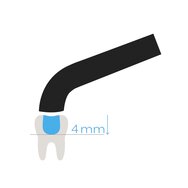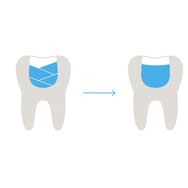One composite for all cases certainly sounds like a handy thing to have. Undeniably, universal composites cover the broadest range of indications in restorative dental procedures. They can be used in the posterior region without limitation and they are also suitable for anterior applications. Given their wide range of shades and low translucency, composite resins allow for restorative work to be done in different opacity levels to achieve a harmonious shade match with the natural tooth structure. Maintaining a diverse range of shades, however, entails high inventory costs for shades that are rarely used. In addition, these composites involve a time-consuming layering technique. With this in mind, bulk-fill materials are seen as a cost-effective alternative, especially for restorations in the posterior region. Concerns related to them being overly translucent or lacking opacity are no longer relevant. Our bulk-fill composites produce natural looking esthetic results thanks to the modern technologies they incorporate.
Compared to universal composites, bulk-fill materials feature a higher level of translucency to facilitate better penetration of light during the curing process in layers of up to 4 mm in thickness. However, the increased translucency has a negative impact on esthetics. Addressing this phenomenon, we developed the patented Aessencio technology that increases the refractive index as the composite undergoes polymerization. This ensures that the opacity of the initially translucent 4-mm composite layer increases as the composite polymerizes, leading to an enamel- or dentin-like final translucency. Natural esthetic properties are achieved this way.
Composite resins consist of various fillers and a monomer mixture. The monomer mixture exhibits a uniform refractive behaviour, while the individual fillers may either share the same refractive behaviour (refractive index) as that of the monomer mixture or differ from it. The principle is: The greater the difference in refractive indices between the filler and the monomer matrix, the more the path of light bends and the less translucent the composite appears. Before polymerization, the composite looks translucent as the difference in refractive indices is minimal. Using the Aessencio technology, the refractive index of the monomer mixture is selected so that, during polymerization, the difference in refractive indices increases, leading to a substantial decrease in translucency. Consequently, the composite becomes more opaque. This unique mixture of monomers and fillers allows the material to visually blend with the surrounding tooth structure and achieve a favourable shade match.
Photoinitiators absorb light at different wavelength ranges. We developed and patented Ivocerin, a photoinitiator that absorbs light at a higher wavelength than standard initiators. This means that any common halogen or LED curing light can be used to activate it. Composites containing Ivocerin exhibit excellent results in bright shades, such as Bleach shades, despite their initial yellow tinge and require a considerably lower photoinitiator concentration to achieve similar properties as standard photoinitiators. Consequently, Ivocerin can be used as a polymerization booster without compromising the esthetic appearance of tooth-coloured composites (or even Bleach shades), providing an enamel-like translucency.
The case study below illustrates the natural esthetic appearance that can be achieved in direct restorations with bulk-fill composite resins: Posterior restoration using Tetric PowerFlow and Tetric PowerFill[1]
Would you like to see the true-to-nature aesthetics of our 4 mm composites for yourself? Then simply try our products for the direct filling therapy workflow:
Given the excellent clinical performance and esthetic properties of restorations made of bulk-fill composites, there is a particular interest in examining the efficiency of this category of materials. The third part of our series on bulk-fill composites will provide specific information on the efficiency of these materials.
[1] Enggist L. New Fast-cure Composite System for Posterior Restorations – 12 Months Results. Präsentation IADR 2019, https://iadr.abstractarchives.com/abstract/ced-iadr2019-3221849/new-fast-cure-composite-system-for-posterior-restorations-12-months-results



